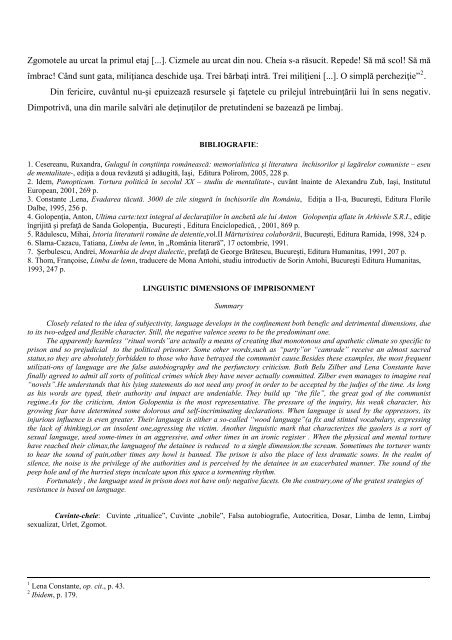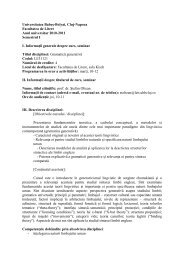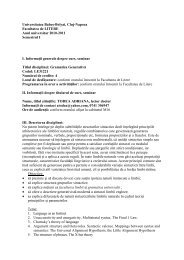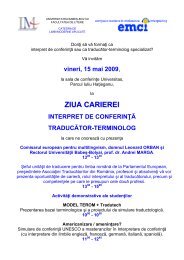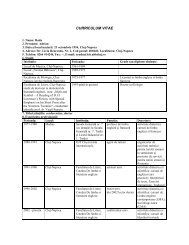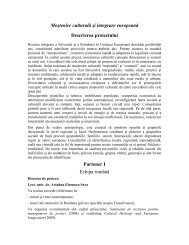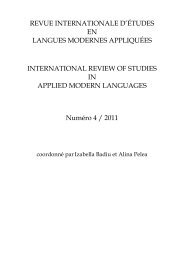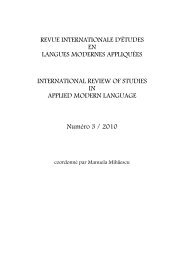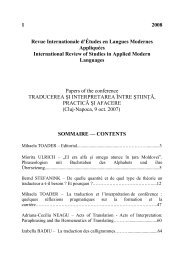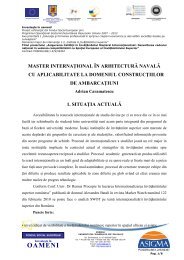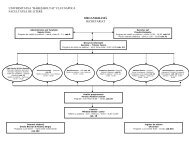Dimensiuni ale limbajului n context carceral
Dimensiuni ale limbajului n context carceral
Dimensiuni ale limbajului n context carceral
Create successful ePaper yourself
Turn your PDF publications into a flip-book with our unique Google optimized e-Paper software.
Zgomotele au urcat la primul etaj [...]. Cizmele au urcat din nou. Cheia s-a răsucit. Repede! Să mă scol! Să mă<br />
îmbrac! Când sunt gata, miliţianca deschide uşa. Trei bărbaţi intră. Trei miliţieni [...]. O simplă percheziţie” 2 .<br />
Din fericire, cuvântul nu-şi epuizează resursele şi faţetele cu prilejul întrebuinţării lui în sens negativ.<br />
Dimpotrivă, una din marile salvări <strong>ale</strong> deţinuţilor de pretutindeni se bazează pe limbaj.<br />
BIBLIOGRAFIE:<br />
1. Cesereanu, Ruxandra, Gulagul în conştiinţa românească: memorialistica şi literatura închisorilor şi lagărelor comuniste – eseu<br />
de mentalitate-, ediţia a doua revăzută şi adăugită, Iaşi, Editura Polirom, 2005, 228 p.<br />
2. Idem, Panopticum. Tortura politică în secolul XX – studiu de mentalitate-, cuvânt înainte de Alexandru Zub, Iaşi, Institutul<br />
European, 2001, 269 p.<br />
3. Constante ,Lena, Evadarea tăcută. 3000 de zile singură în închisorile din România, Ediţia a II-a, Bucureşti, Editura Florile<br />
Dalbe, 1995, 256 p.<br />
4. Golopenţia, Anton, Ultima carte:text integral al declaraţiilor în anchetă <strong>ale</strong> lui Anton Golopenţia aflate în Arhivele S.R.I., ediţie<br />
îngrijită şi prefaţă de Sanda Golopenţia, Bucureşti , Editura Enciclopedică, , 2001, 869 p.<br />
5. Rădulescu, Mihai, Istoria literaturii române de detentie,vol.II Mărturisirea colaborării, Bucureşti, Editura Ramida, 1998, 324 p.<br />
6. Slama-Cazacu, Tatiana, Limba de lemn, în „România literară”, 17 octombrie, 1991.<br />
7. Şerbulescu, Andrei, Monarhia de drept di<strong>ale</strong>ctic, prefaţă de George Brătescu, Bucureşti, Editura Humanitas, 1991, 207 p.<br />
8. Thom, Françoise, Limba de lemn, traducere de Mona Antohi, studiu introductiv de Sorin Antohi, Bucureşti Editura Humanitas,<br />
1993, 247 p.<br />
LINGUISTIC DIMENSIONS OF IMPRISONMENT<br />
Summary<br />
Closely related to the idea of subjectivity, language develops in the confinement both benefic and detrimental dimensions, due<br />
to its two-edged and flexible character. Still, the negative v<strong>ale</strong>nce seems to be the predominant one.<br />
The apparently harmless “ritual words”are actually a means of creating that monotonous and apathetic climate so specific to<br />
prison and so prejudicial to the political prisoner. Some other words,such as “party”or “camrade” receive an almost sacred<br />
status,so they are absolutely forbidden to those who have betrayed the communist cause.Besides these examples, the most frequent<br />
utilizati-ons of language are the false autobiography and the perfunctory criticism. Both Belu Zilber and Lena Constante have<br />
finally agreed to admit all sorts of political crimes which they have never actually committed. Zilber even manages to imagine real<br />
“novels”.He understands that his lying statements do not need any proof in order to be accepted by the judjes of the time. As long<br />
as his words are typed, their authority and impact are undeniable. They build up “the file”, the great god of the communist<br />
regime.As for the criticism, Anton Golopentia is the most representative. The pressure of the inquiry, his weak character, his<br />
growing fear have determined some dolorous and self-incriminating declarations. When language is used by the oppressors, its<br />
injurious influence is even greater. Their language is either a so-called “wood language”(a fix and stinted vocabulary, expressing<br />
the lack of thinking),or an insolent one,agressing the victim. Another linguistic mark that characterizes the gaolers is a sort of<br />
sexual language, used some-times in an aggressive, and other times in an ironic register . When the physical and mental torture<br />
have reached their climax,the languageof the detainee is reduced to a single dimension:the scream. Sometimes the torturer wants<br />
to hear the sound of pain,other times any howl is banned. The prison is also the place of less dramatic souns. In the realm of<br />
silence, the noise is the privilege of the authorities and is perceived by the detainee in an exacerbated manner. The sound of the<br />
peep hole and of the hurried steps inculcate upon this space a tormenting rhythm.<br />
Fortunately , the language used in prison does not have only negative facets. On the contrary,one of the gratest srategies of<br />
resistance is based on language.<br />
Cuvinte-cheie: Cuvinte „ritualice”, Cuvinte „nobile”, Falsa autobiografie, Autocritica, Dosar, Limba de lemn, Limbaj<br />
sexualizat, Urlet, Zgomot.<br />
1 Lena Constante, op. cit., p. 43.<br />
2 Ibidem, p. 179.


